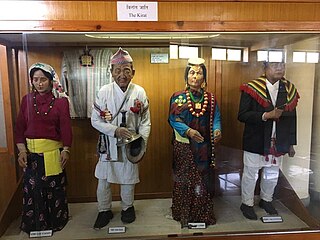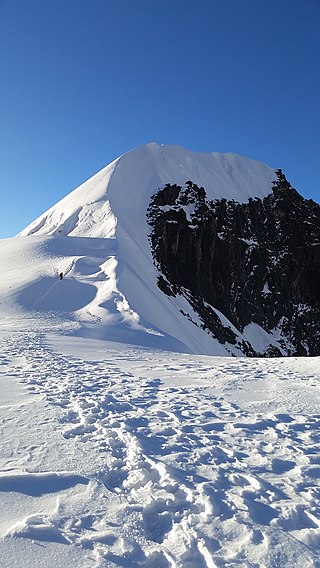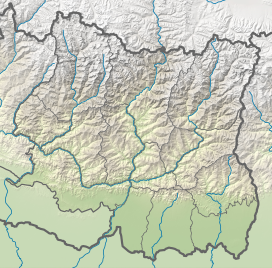
Kangchenjunga, also spelled Kanchenjunga, Kanchanjanghā and Khangchendzonga, is the third-highest mountain in the world. Its summit lies at 8,586 m (28,169 ft) in a section of the Himalayas, the Kangchenjunga Himal, which is bounded in the west by the Tamur River, in the north by the Lhonak River and Jongsang La, and in the east by the Teesta River. It lies in the border region between Nepal and Mangan district, Sikkim state of India, with three of the five peaks, namely Main, Central and South, directly on the border, and the peaks West and Kangbachen in Nepal's Taplejung District.
The Kirat or Kirati people are indigenous ethnic groups of the Himalayas.

Yakkha is an indigenous ethnic group from the Indian subcontinent, mainly in modern-day Nepal and present-day India. It is one of the descendants of Nepal's prehistoric Kirat dynasty. The Yakkha people are subsistence farmers who inhabit the lower Arun valley in eastern Nepal. They number only a few thousand and their language is nearly extinct.

Solukhumbu District (Nepali: सोलुखुम्बु जिल्ला[solukʰumbu], Sherpa: ཤར་ཁུམ་བུ་རྫོང་།, Wylie: shar khum bu dzong) is one of 14 districts of Province No. 1 of eastern Nepal. As the name suggests, it consists of the subregions Solu and Khumbu.

The Kirati people, also spelled as Kirant or Kiranti, are a Sino-Tibetan ethnic group. They are peoples of the Himalayas, mostly the Eastern Himalaya extending eastward from Nepal to North East India.

Chyasal is an ancient town in the District of Lalitpur in Bagmati Zone in Nepal and a section of the city of Lalitpur. Also known as Yala in Nepal Bhasa. The 800 Kiratis are said to been slain in this Dabu by Lichhavis. Yalamber was a Kirat King who settled in Nepal mainly in Ye and surrounding region of Khopa (Bhaktapur) and Yala (Lalitpur).

Tharpu Chuli or Tent Peak is one of the trekking peaks in the Nepali Himalaya range. The peak has a nice central position in the Annapurna Sanctuary. It is easier to climb than both Hiunchuli and Singu Chuli which also are trekking peaks of the Annapurna. The ascent requires ice climbing equipment. A climbing permit from the NMA used to cost US$350 for a team of up to four members. As of 2017 NMA has removed Tharpu Chuli from its list of Trekking Peaks.

Singu Chuli is one of the trekking peaks in the Nepali Himalaya range. The peak is located just west of Gangapurna in the Annapurna Himal. Singu Chuli is on a ridgeline originating at Tarke Kang going south. This ridge continues south of Singu Chuli to Tharpu Chuli. A climbing permit from the NMA costs US$350 for a team of up to four members. The peak requires ice climbing equipment.

Kirat Mundum, also known as Kiratism, or Kirati Mundum, is a folk religion that is indigenous to the Kirati ethnic groups of Nepal, Darjeeling and Sikkim, majorly practiced by Yakkha, Limbu, Sunuwar, Rai, Thami, Jirel, Hayu and Surel peoples in the north-eastern Indo subcontinent. The practice is also known as Kirat Veda, Kirat-Ko Veda or Kirat Ko Ved. According to some scholars, such as Tom Woodhatch, it is a blend of shamanism, animism, and Shaivism. It is practiced by about 3.1% of the Nepali population as of 2011.

Yalamber or Yalung, Yalambar, Yalamwar, Yalamver was a Kirat warrior and first King of Kirata Kingdom in Nepal. He established Kirata Kingdom in 800 B.C. His capital was Yalakhom, present day Kathmandu Valley (Thankot) after conquering Central Nepal and his kingdom extended from river Trishuli in the west to river Teesta in the east of Bhutan. Patan also known as is resemblance to Yalamber as he ruled the regions.
Yuma Sammang is the goddess of the Limbu community of Nepal. The deity Yuma Sammang also known as Ningwaphuma is the most important and popular among Yakthungs (Limbus) and worshiped in all occasion. Yuma is regarded as the mother by Yakthungs. Yuma Samyo or Yuma religion was very popular during Yet Hang age and Thibong Yakthung age. After the Khas Aryan oppression in Yakthung laje (Limbuwan), and introduction of Hinduism from Indian mainland majority of Yakthungs had stopped following the Yuma religion for centuries. The Khas-Aryas also gave the term 'Kirata' to the tribes of the Himalayas. This has in time caused a false belief among sunuwars, yakhas, limbus and the 32 rai tribes that they are all a part of the same ethnic group. In fact, most of these groups are very different from each other, only sharing cultural and lingual similarities because of their close settlements. The Limbus being very distinct from the other so called 'Kiratas' as they do not worship Sumnima and Paruhang. They worship Yuma Sammang on most occasions with the Nembang Clan being an exception as they recognize Theba sammang as their supreme deity. A lot of confusion has occurred since the founding of the Satyahangma Kirat Religion as it states that Sumnima-Paruhang and Yuma-Theba are the same, which is false. The Satyahangma Kirat Religion was created during the reign of the Ranas and it incorporated many Hindu traditions and rituals into the traditional Mundhum of the Limbus. While sharing similar terms [Mundhum{traditional}(Limbu) Mundum(Rai)], the tales within these vocally passed down religions are very different from each other with different characters and events. The lingual difference, cultural difference and various physical traits such as the cranial height and nasal height & breadth also have showed that Limbus and the other so called kiratas are not from the same ancestral family. Studies have also shown that Limbus are more closely related to Tibetans than the rais and sunuwars.

Gimmigela Chuli, or The Twins, are two-peak mountains in the Himalayas, located on the border between Taplejung, Mechi, Nepal and Sikkim, India.

The Likhu Khola is a left tributary of the Sun Koshi in the Himalayas in eastern Nepal. Given named by Kirat kingdom Likhu or Liku in the Sunuwar language means Top (Hill) Water.

The Kirat Region is an area of the Himalayas in eastern Nepal which is inhabited by ethnic Kirati people. Currently Province No. 1 of Nepal has been proposed to be named Kirat Pradesh or Kirat State.
The earliest inhabitants of modern Nepal and adjoining areas are believed to be people from the Indus Valley civilization. By 4000 BCE, the Tibeto-Burmese people had reached Nepal either directly across the Himalayas from Tibet or via Myanmar and north-east India or both. By the late Vedic period, Nepal was being mentioned in various Hindu texts, such as the late Vedic Atharvaveda Pariśiṣṭa and in the post-Vedic Atharvashirsha Upanishad. The Gopal Bansa was the oldest dynasty to be mentioned in various texts as the earliest rulers of the central Himalayan kingdom known by the name 'Nepal'. The Gopalas were followed by Kiratas who ruled for over 16 centuries by some accounts. According to the Mahabharata, the then Kirata king went to take part in the Battle of Kurukshetra. In the south-eastern region, Janakpurdham was the capital of the prosperous kingdom of Videha or Mithila, that extended down to the Ganges, and home to King Janaka and his daughter, Sita.
Lugula Himal is a mountain peak in the Himalayas, located on the border of North western region of Nepal and the Tibet Autonomous Region of China.
Ratna Chuli is a mountain peak in the Himalayas on the border of Nepal and Tibet Autonomous Region.
Pathibara is a mountain peak located on the border of Nepal and North Sikkim, India.

Thulagi Chuli is a mountain in Mansiri Himal, a high subrange of the Himalayas in north-central Nepal.















